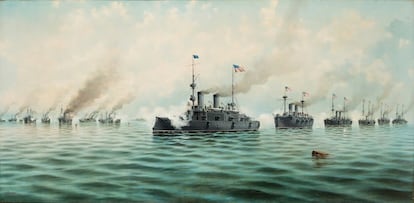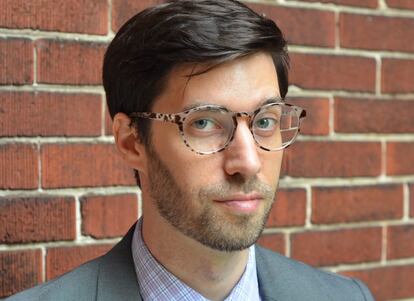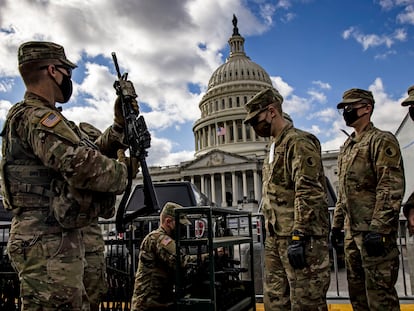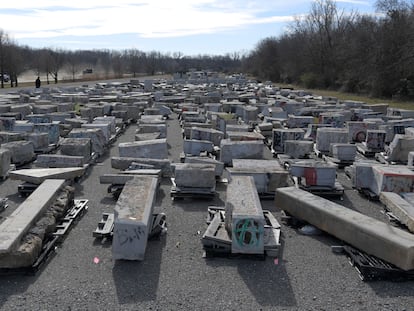The United States revises its imperial past (and present)
An exhibition in Washington DC and a book by historian Daniel Immerwahr take stock of the conflictive relationship between the United States and its colonies. ‘It’s reasonable to think that Puerto Rico could become a state in the next 15 years,’ Immerwahr notes


“War,” said comedian Jon Stewart, “is God’s way of teaching Americans geography.”
The quote – sometimes misattributed to Ambrose Bierce or Mark Twain – is used by historian Daniel Immerwahr in his book, How to Hide an Empire. The professor at Northwestern University, north of Chicago, argues that the relationship that Americans have with their compatriots in their colonies (or territories, as they prefer to call them) is both a cause and consequence of that geographical ignorance.
“Americans,” Immerwahr clarifies – in an interview with EL PAIS that took place at the beginning of May – “have had a kind of anti-imperial sense of themselves that has made it hard for them to really take seriously the colonies of the United States.”
“It’s a consequence of privilege,” he continues. “If you don’t have to know things, it becomes very easy not to know them. I don’t judge Americans for this, but I just recognize that it’s because they’re in this position of tremendous privilege with respect to the rest of the planet. They have this ability to not think very hard about the rest of the world – other parts of the world don’t have that privilege.”
In his book, Immerwahr reviews American imperial history as a drama in three acts. First, there’s Western expansion and the genocide of the Native Americans, as well as the Texas-sized bite that was taken out of Mexico. “In that first act [which ends in 1854], the empire isn’t hidden, but in plain sight,” Immerwahr explains.

After that, the overseas adventures begin, with the annexation of dozens of uninhabited islands in the Caribbean and the Pacific, to ensure the supply of guano for agriculture. This is followed by the Alaska Purchase of 1867; the 1898 absorption of the remnants of the Spanish empire (Philippines, Puerto Rico and Guam); the annexation of Hawaii, Wake Island and American Samoa and, in 1917, the purchase of the US Virgin Islands from Denmark.
As part of the debate stirred by the book, the National Portrait Gallery in Washington, DC has joined the historiographic revision, with an exhibition about that period of time that has been called the “best and most-engaging work the National Portrait Gallery has done in a decade,” according to The Washington Post. Titled 1898: US Imperial Visions and Revisions, the exhibition explores the history of American colonization and its consequences from a pivotal year, with the Spanish-American War in the background.
The third phase of colonization comes at the end of World War II and is the most paradoxical of the three. In 1945 – when the country’s land area had reached its zenith and the “Greater United States” was home to some 135 million people inside and outside the continental zone – Washington decided to release most of that territory, rather than attempt to secure it. The Philippines obtained its independence; Puerto Rico became a Freely Associated State (FAS) – a status that the inhabitants still have, as US citizens without the right to vote in presidential elections (only in primaries) – and Alaska and Hawaii eventually defeated racist resistance to become states.
At this point, “another type of imperialism” begins: one that is economic, technological and cultural in nature. A form of “coca-colonization” – as it was baptized in France – which continues to this day. Washington still has 750 military bases in 42 countries.
“It’s interesting that there’s one anti-imperialist slogan that’s sort of famous enough that people in the United States know it: Yankee go home! It’s a reference mainly to soldiers. It’s not about, like, take your movies and go away. It’s about, literally, ‘you people need to stop being here.’ And that’s because the United States has military bases throughout the planet.”

Beyond that catchy phrase, “none of all that,” writes Immerwahr, has left “much of a mental imprint” on national historiography, much less on ordinary Americans. He thinks about his country as a “logo map,” which is what political scientist Benedict Anderson called the silhouette delimited by Canada, Mexico, the Pacific and the Atlantic. In the best-case scenario, Alaska and Hawaii are included in this depiction, deformed for reasons of design. Between the easternmost and westernmost points of Alaska, there is a distance similar to that which separates the two coasts of the continental United States.
This forgetfulness, the historian thinks, stems from self-interest. “At the turn of the century, the ‘c’ word [colonies] became taboo,” Immerwahr writes in his book. The change is marked by the arrival of Woodrow Wilson to the White House (1913-1921).
“He grew up in the south during and after the Civil War, and he regarded the southern states of the United States as having been conquered provinces of the North. He criticized empire in his writings, he talked about the importance of liberty,” the historian notes during the interview. “But when it came to Haiti, he was perfectly content to see his administration launch an occupation that ended up lasting for 19 years. Wilson had a clear sense of certain people who were fit for self-government and certain people who were not, in a racial sense. The form of empire that he found most distasteful was a kind of empire where white people conquered other white people. That was what he grew up with. And that was what he objected to. He was far more comfortable with white people colonizing non-white people.”
In few moments was this concealment of the empire as flagrant as after the attack on Pearl Harbor. December 7, 1941, was “a date which will live in infamy,” as defined by President Franklin D. Roosevelt. Few were aware that, on the day the Japanese Army attacked, in addition to Hawaii, they also hit the Philippines, Guam, and the islands of Midway and Wake, in addition to several British colonies. In the book, Immerwahr explains that this information was crossed out from Roosevelt’s speech – the president preferred to ignore the rest of the territories and focus on the message that the affront had been against US territory. The Philippines and Guam were also controlled by the United States, but how many American citizens were even aware of this? He cut them to avoid confusion.
The inhabitants of the Philippines – whose commander-in-chief was Roosevelt – saw this oversight as a disappointment. “Some people like to make that argument that, compared to what Spain did in the Philippines, the United States, you know, invested in schools and participated in economic development – there’s the idea that the US was a benign colonizer. But in my book, I talk about both the war that the United States used to pacify the Philippines, and then how the United States failed to defend the Philippines in World War II, which turned out to be extraordinarily violent and resulted in the deaths of over a million Filipinos.”
“I have a hard time seeing the United States as a benevolent colonizer,” Immerwahr sighs. “And that’s partly because empire is just a violent form of government – it rarely turns out particularly well for the colonized.”
Proximity with China
And what of Guam? It remains a forgotten place in the middle of the Pacific. US media only pays attention to it when, like a couple of weeks ago, a cyclone devastates the island, or when they put their geopolitical analysts to work: due to its proximity to China, Guam could be the point where World War III breaks out.
The case of Puerto Rico also takes up a good part of Immerwahr’s book. “For much of the 20th century, US legislators were unwilling to consider Puerto Rico as really being part of the United States. And a lot of that had to do with a sense that Puerto Ricans were racially different – even though a lot of Puerto Ricans consider themselves to be white,” Immerwahr explains. “The politics of status – between statehood and independence – have been complicated in Puerto Rico. At the start of annexation, there was an elite movement towards statehood and a hope that Puerto Rico would become a state. But by the 1930s there was a really serious independence movement, which is no longer a majority position, although it is culturally significant. Puerto Ricans have become accustomed to living under the United States, but with a different culture from that of the mainland, including the fact that they speak Spanish.”
The historian thinks that the debate on Puerto Rico has been placed in a more central place since he began writing the book back in 2010. This is despite the fact that many of his compatriots on the continent, “still kind of think of Puerto Rico as a foreign country.” This is changing, however, in part thanks to recent cultural exports, such as the singer Bad Bunny. Another turning point came with Hurricane Maria in 2017. “After Trump started behaving so arrogantly toward Puerto Rico, paying attention to the hurricane damage on the island became a way of opposing Trump.”
“For the first time, according to the surveys, a majority – admittedly a slim one – of Puerto Ricans would seek statehood,” he continues. “And although there’s bipartisan support for Puerto Rican statehood. There’s also bipartisan opposition. I’m puzzled why the Democrats don’t push for Puerto Rican statehood, as this would probably be a reliable basis of Democratic support.”
“In the next 15 years, I think we could imagine Puerto Rico becoming a state. I think there’s a sense that Puerto Rico and DC are the most likely [future] states – their statehood campaigns might be linked together, in the way that Alaska and Hawaii statehood campaigns were.”
Another unexpected change since he began this project, Immerwahr adds, was the return of old-fashioned imperial expansion, with the Russian invasion of Ukraine. There has also been a change in attitude towards China.
“They could invade Taiwan, but I don’t anticipate that happening anytime soon. Beijing has invested heavily in other types of expansion, such as the Belt and Road initiative [known as ‘The New Silk Road’] or the creation of artificial islands in the South China Sea. It’s a way of gaining territory, but without taking it from anyone.”
Meanwhile, the historian notes, the US is advancing in its imperial decline. “The United States isn’t expanding [its territory or bases] and is, arguably, contracting its military base structure. I see no possibility that it will claim or annex new territories anytime soon.”
“It’s quite clear that the United States still has the largest economy, still has the most-powerful military… but its power over other countries is weakening,” he emphasizes. “One argument against this being a good thing comes from political scientists, who believe that having one country that is clearly the police power turns out to be really good for securing peace – [the notion that] you just need one country that’s capable of managing disputes and threatening anyone who gets out of line. And I think that it’s unclear if that’s true. In the last 50 years, we’ve seen that the US has declined in power… but we’ve also seen more peace. So, it’s not clear to me what would happen if we saw a further democratization of power. I suspect it might also be good for peace, although that’s really hard to say.”
Sign up for our weekly newsletter to get more English-language news coverage from EL PAÍS USA Edition
Tu suscripción se está usando en otro dispositivo
¿Quieres añadir otro usuario a tu suscripción?
Si continúas leyendo en este dispositivo, no se podrá leer en el otro.
FlechaTu suscripción se está usando en otro dispositivo y solo puedes acceder a EL PAÍS desde un dispositivo a la vez.
Si quieres compartir tu cuenta, cambia tu suscripción a la modalidad Premium, así podrás añadir otro usuario. Cada uno accederá con su propia cuenta de email, lo que os permitirá personalizar vuestra experiencia en EL PAÍS.
¿Tienes una suscripción de empresa? Accede aquí para contratar más cuentas.
En el caso de no saber quién está usando tu cuenta, te recomendamos cambiar tu contraseña aquí.
Si decides continuar compartiendo tu cuenta, este mensaje se mostrará en tu dispositivo y en el de la otra persona que está usando tu cuenta de forma indefinida, afectando a tu experiencia de lectura. Puedes consultar aquí los términos y condiciones de la suscripción digital.
More information
Archived In
Últimas noticias
Europe urges Trump to respect Greenland following annexation threats
Science seeks keys to human longevity in the genetic mixing of Brazilian supercentenarians
Luisa Neubauer, climate change activist: ‘Ecology shouldn’t be a punitive force, but a joyful and liberating one’
Trump followed CIA recommendation to hand power to Delcy Rodríguez due to risk that Machado would not control the army
Most viewed
- Alain Aspect, Nobel laureate in physics: ‘Einstein was so smart that he would have had to recognize quantum entanglement’
- Alvin Hellerstein, a 92-year-old judge appointed by Bill Clinton, to preside over Maduro’s trial in New York
- Cuba confirms death of 32 of its citizens in the US attack against Venezuela
- Gilles Lipovetsky: ‘If you want to live better and fall in love, take Prozac, don’t look to philosophy’
- Why oil has been at the center of Venezuela-US conflicts for decades










































